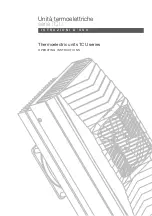
www.lifebreath.com
26
17
S
ERVICE AND
M
AINTENANCE
Filters
Open front service door to access the filters located in both supply and exhaust air streams. Note to remove
and install filters, it may be easier to first remove the core(s). Refer to
The filters are designed to stop large particles from entering in the core. The filters are fastened in place by a
metal spring rod. To remove filters from core(s) simply pull the rod from one end, outward until free from core
lip, and remove.
Only use cold water with a mild detergent to wash the filters. Do not wring out or use harsh chemicals. The
time between filter service will depend on the application the HRV has been installed in. It can be as often as
one - two months or at the very least, cleaned every six months.
Condensate Drains
The condensate drain consists of one drain pan, which may collect water after the HRV initiates a defrost
cycle, and a drain line to remove the condensate.
Maintenance on this portion of the system should be done as often as possible and should not exceed six
months. Note bacterial growth in standing water is a major concern to healthy indoor air quality, and should
be avoided whenever possible.
To clean these components, open the front service door and flush the pans with water. Ensure that the pans
drain completely and in a reasonable amount of time. Note if the water does not drain right away, check for
blockage in the drain line, also check that the drain line has a good slope to it. (1/8 -
1/4” per foot)
The drain line itself should have a “P” trap in it below the HRV which is to be filled with water to prevent odors
or gases from entering back into the unit.
Duct Work
It is a good idea to inspect ducting, outside weatherhoods (wall caps), and grilles for blockage and dirt
buildup, at least every six months.
Outside weatherhoods should be protected by a bird screen which can plug up with debris. Also, it is a good
idea to visually confirm that the fresh air supply is free from any sources of contamination, such as other
vented combustion equipment added after the fact.
Damper Motor
The damper motor, (if applicable) is a self-contained motor and does not require service. The damper door
attached to the motor could use a little lithium grease on the shaft opposite the motor, where it enters its
holder, once every two to three years.
General Maintenance
As a final step in a routine maintenance schedule, it is a good idea to confirm operation of the system,
checking speed control functions and remote control operation, if applicable. Wipe the inside of the cabinet to
remove dust and cobwebs as needed. It is a good idea to keep a service/maintenance log of the unit.





































